Ferns of the Adirondacks:
Hay-scented Fern (Dennstaedtia punctilobula)
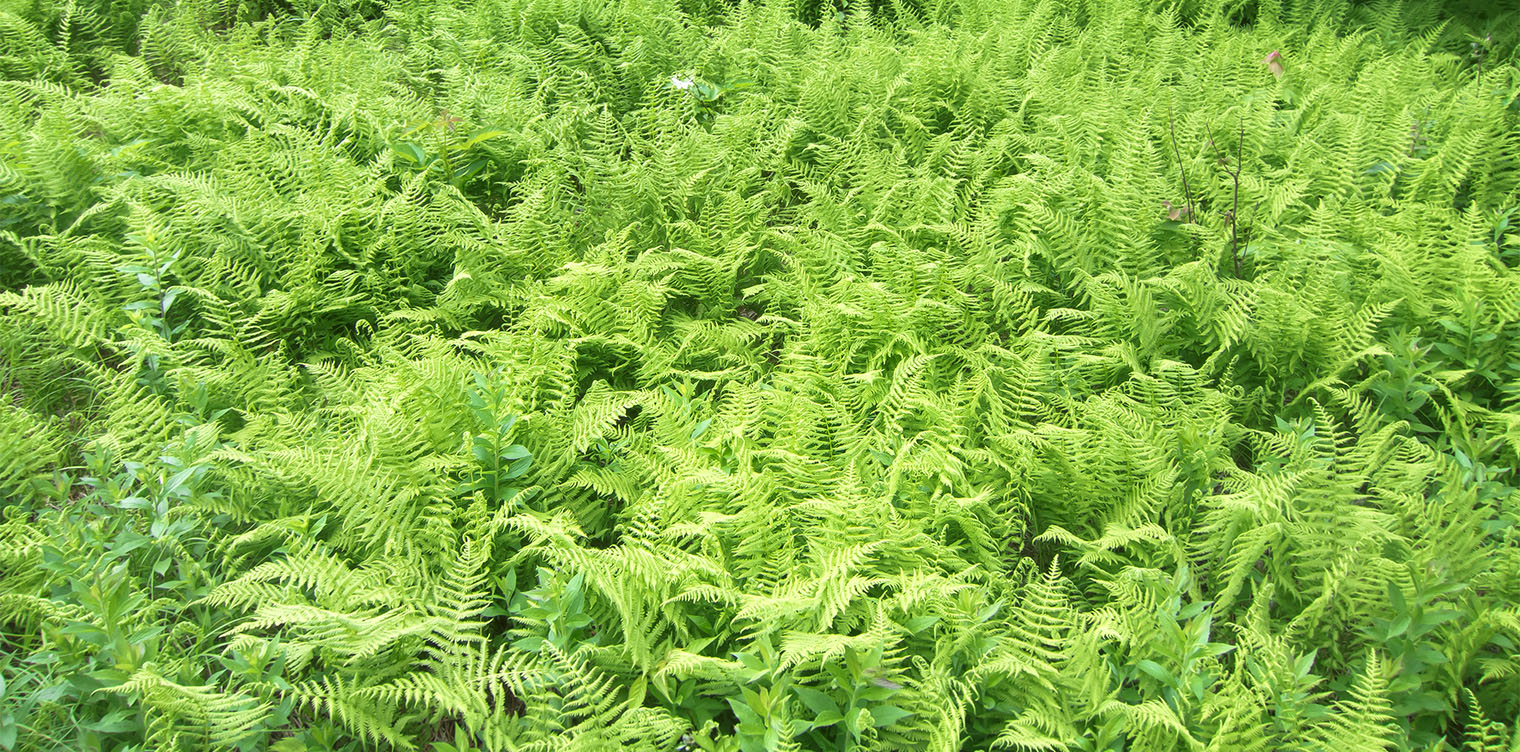
The Hay-scented Fern (Dennstaedtia punctilobula) is a yellowish green fern with feathery fronds that give off a scent of crushed hay in late summer. Hay-scented Ferns grow in meadows and sunny openings in the forest canopy throughout the Adirondacks and turn a golden yellow in the fall.
- Hay-scented Fern's common name derives from the fact that its fronds smell like new-mown hay when crushed. Other common names for the Hay-scented Fern are Eastern Hayscented Fern, Eastern Hay-scented Fern, and Boulder Fern. The latter name refers to the fact that the fern is often found in stony places.
- The genus name (Dennstaedtia) refers to August W. Dennstaedt, a German botanist who died in 1826. The species name (punctilobula) is from the Latin, meaning "with small dotted lobes." This is a reference to the appearance of the soriSorus: A cluster of sporangia, usually borne on the underside or margins of the pinnae or pinnules. (plural = sori) (the clusters of fruit dots on the back of the blades) on the lobes of the pinnules
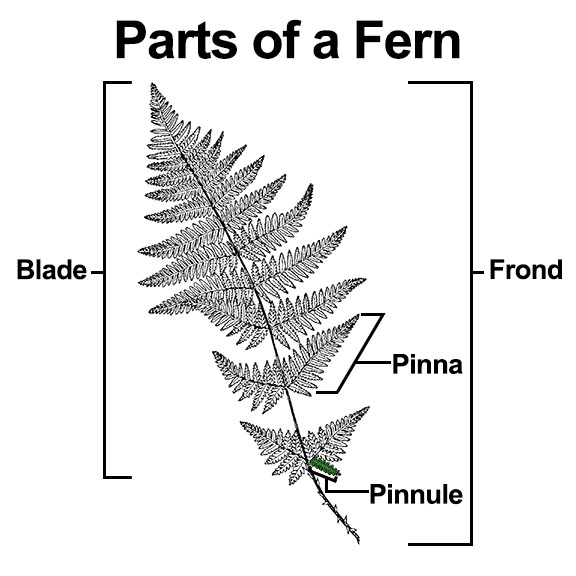 Pinnule: A division of the pinna..
Pinnule: A division of the pinna.. - Sources published in the 19th and early 20th centuries use the earlier scientific name: Dicksonia punctilobula. Other common names in use at that time include Fine-haired Mountain Fern, Pasture Fern, and Hairy Dicksonia.
The Hay-scented Fern is a member of the Dennstaedtiaceae family. The other member of this family that grows in the Adirondacks is Eastern Bracken Fern. The Hay-scented Fern is one of three ferns in New York State that are not protected. The other two are Sensitive Fern and Eastern Bracken Fern.
Identification of Hay-scented Ferns
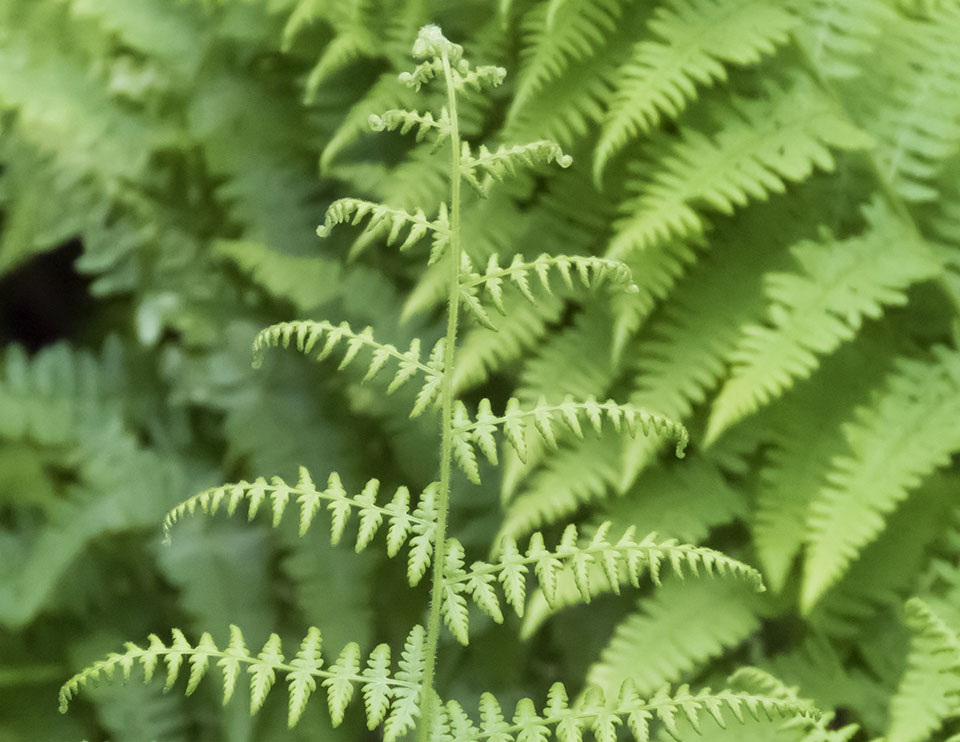
The Hay-scented Fern is a light green or yellowish green fern with feathery fronds which turn golden brown or yellow in the autumn. This fern grows from one to three feet tall, forming loose clusters of erect, deciduous fronds with long, tapering relaxed tips. Unlike the Sensitive Fern and Cinnamon Fern, the sterile and fertile fronds of Hay-scented Ferns are similar in size and shape.
- The Hay-scented Fern grows from slender, creeping rhizomes
 Rhizome: The modified subterranean stem of a plant that sends out roots and shoots from its nodes. Rhizomes are also called creeping rootstalks and rootstocks., which grow rapidly, allowing this plant to form large clonal colonies.
Rhizome: The modified subterranean stem of a plant that sends out roots and shoots from its nodes. Rhizomes are also called creeping rootstalks and rootstocks., which grow rapidly, allowing this plant to form large clonal colonies. - The rachis
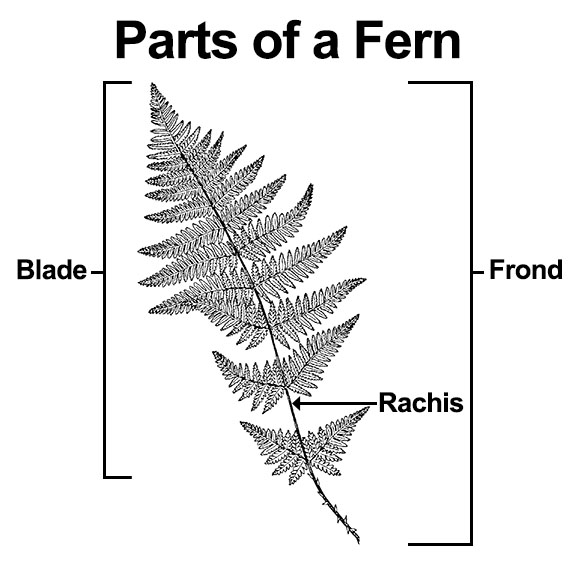 Rachis: The stalk within the blade (the expanded, leafy part of the frond). (the stalk within the blade) is slender, pale to straw-colored, and covered with hairs.
Rachis: The stalk within the blade (the expanded, leafy part of the frond). (the stalk within the blade) is slender, pale to straw-colored, and covered with hairs. - The stipe
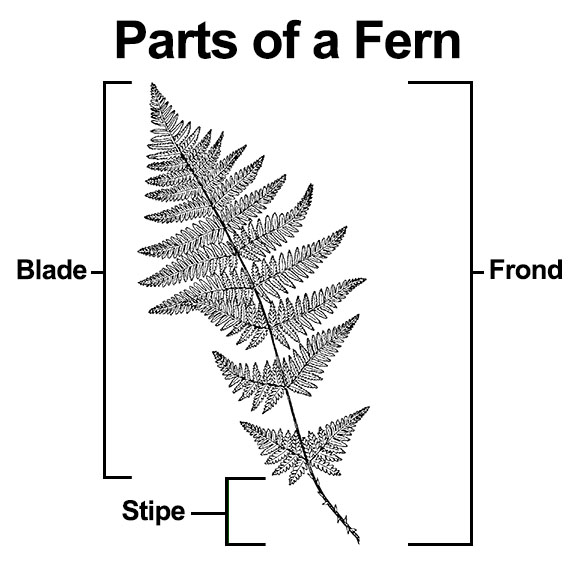 Stipe: The stalk below the blade (the expanded, leafy part of the frond). (the stalk below the blade) is dark brown at the base and covered with white hairs. It is greenish or yellowish above.
Stipe: The stalk below the blade (the expanded, leafy part of the frond). (the stalk below the blade) is dark brown at the base and covered with white hairs. It is greenish or yellowish above. - The pinnae
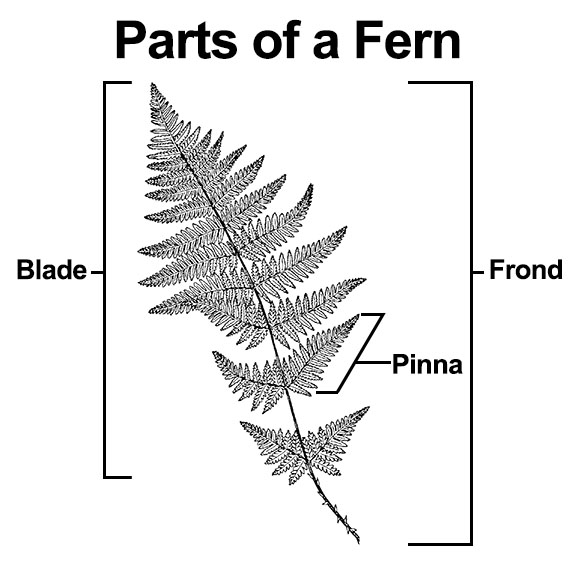 Pinna: A primary division of the blade (plural: pinnae). (leaflets) of Hay-scented Ferns are wavy, with tapering tips. They are covered with soft hair on both surfaces. The pinnae are divided into many small, whitish gland-tipped pinnules
Pinna: A primary division of the blade (plural: pinnae). (leaflets) of Hay-scented Ferns are wavy, with tapering tips. They are covered with soft hair on both surfaces. The pinnae are divided into many small, whitish gland-tipped pinnules Pinnule: A division of the pinna. (sub-leaflets).
Pinnule: A division of the pinna. (sub-leaflets). - The soriSorus: A cluster of sporangia, usually borne on the underside or margins of the pinnae or pinnules. (plural = sori) are very small and occur at the margins of pinnules. They are surrounded by a unique, cup-shaped indusiumIndusium: A thin layer of cells which usually covers and protects the sorus. (plural = indusia).
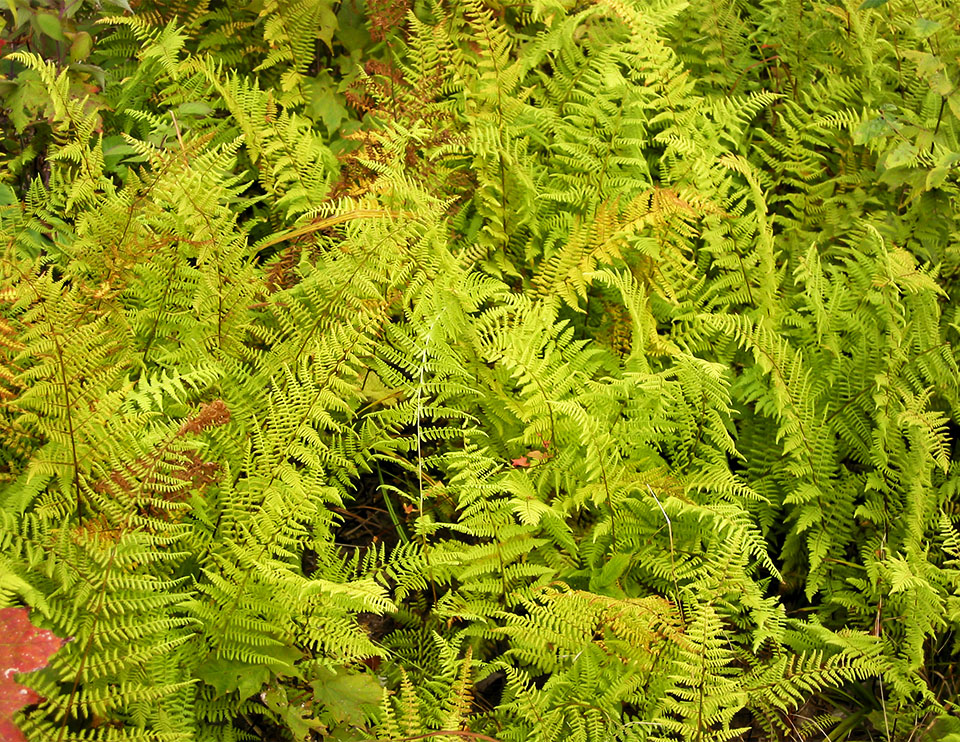
Hay-scented Ferns can sometimes be confused with several other ferns of similar appearance. Hay-scented Ferns can be distinguished from Northern Lady Fern (Athyrium angustum) and Bulblet Fern (Cystopteris bulbifera) – both of which grow in the Adirondack Park – by the characteristic odor of its fronds when brushed, its brown stipe Stipe: The stalk below the blade (the expanded, leafy part of the frond) (the stalk below the blade
Stipe: The stalk below the blade (the expanded, leafy part of the frond) (the stalk below the blade Blade: The expanded, leafy part of the frond.); the glandular hairs on the rachis
Blade: The expanded, leafy part of the frond.); the glandular hairs on the rachis Rachis: The stalk within the blade (the expanded, leafy part of the frond)., and the characteristic cup-like shape of the indusiaIndusium: A thin layer of cells which usually covers and protects the sorus. (plural = indusia).
Rachis: The stalk within the blade (the expanded, leafy part of the frond)., and the characteristic cup-like shape of the indusiaIndusium: A thin layer of cells which usually covers and protects the sorus. (plural = indusia).
Hay-scented Ferns can be distinguished from New York Ferns (Thelypteris noveboracensis) – another fern common in the Adirondack region – by its triangular fronds. The fronds of Hay-scented Ferns are triangular, while those of the New York Fern are widest in the middle and taper to tiny leaflets at the bottom.
Uses of Hay-scented Ferns
Hay-scented Ferns have very limited medicinal uses, although a few native American groups made use of the plant as a treatment for several ailments. The Cherokee used a compound infusion for chills. The Mahuna used the fern to treat lung hemorrhages. No records of edible uses were found.
Wildlife Value of Hay-scented Ferns
The Hay-scented Fern's ecological value to wildlife appears to be quite low. Like most ferns, the Hay-scented Fern does not represent a major food source, although a few insects reportedly feed on the its spore-bearing structures. Despite the abundance of these ferns, White-tailed Deer apparently do not relish them, in part because the foliage is covered with tiny hairs the exude a sticky substance. This allows Hay-scented Ferns to form dense colonies in the forest understory, in some cases shading out tree seedlings. Large colonies of Hay-scented Ferns may provide protective cover for some species.
Distribution of Hay-scented Ferns
Hay-scented Ferns are common throughout northeast and central North America. They can be found in the eastern US and Canada, south to Georgia. They are listed as Endangered in Illinois and Probably Extirpated in Michigan.
Hay-scented Ferns have been documented in all counties within New York State, including all counties within the Adirondack Park Blue Line.
Habitat of Hay-scented Ferns
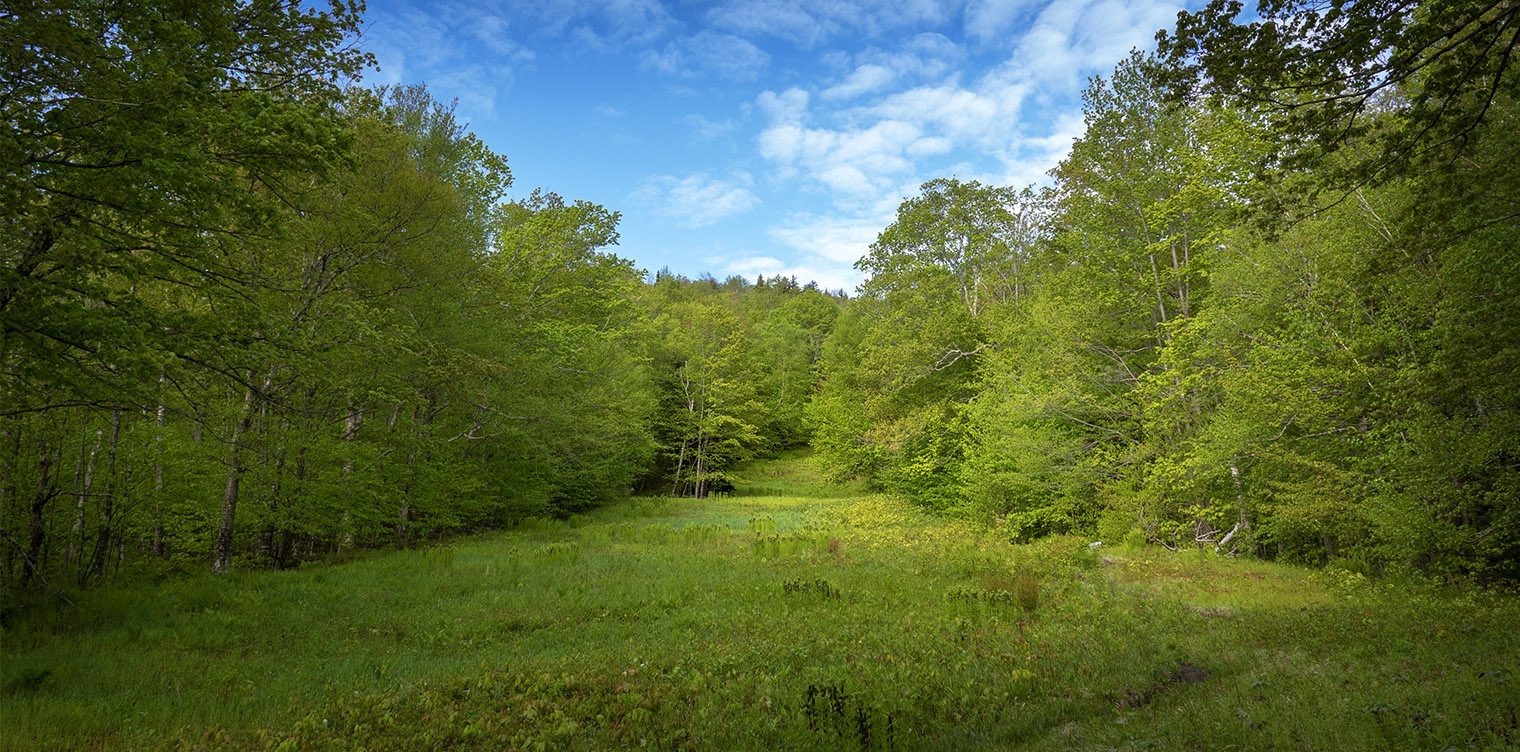
Hay-scented Ferns are relatively flexible in terms of site requirements. They do best in well-drained, acidic soil and full sun, but can also grow in partial shade and wetter soils. In terms of habitat, they are found in forest edges and canopy openings, along the sides of trails and roads, on hillsides, stream banks, and rocky slopes, and in meadows, old fields, hardwood forests, mixed wood forests, and mountain conifer forests. Hay-scented Ferns are quick to colonize logged-over sites, sometimes inhibiting forest regeneration by crowding out tree seedlings.
In the Adirondack Mountains, Hay-scented Ferns can be found in a variety of ecological communities, including:
- Beech-Maple Mesic Forest
- Hemlock-Northern Hardwood Forest
- Mountain Spruce-Fir Forest
- Spruce-Northern Hardwood Forest
- Successional Fern Meadow
- Successional Northern Hardwoods
- Successional Old Field
- Successional Shrubland
For instance, the successional old field ecological community is a meadow dominated by wildflowers, ferns, and grasses; these are sites that have previously been cleared, mainly for agriculture.
- In this ecological community, you'll typically see Hay-scented Ferns growing among wildflowers such as goldenrods, hawkweeds, dandelions, Oldfield Cinquefoil, Common Evening Primrose, Field Chickweed, New England Aster, and Queen Anne's Lace.
- Butterflies to look for when you find Hay-scented Ferns growing in old fields include Black Swallowtail, Orange Sulphur, and Eastern Tailed Blue.
- Birds that are commonly seen on old fields include Savannah Sparrow, Field Sparrow, and American Goldfinch.
- Characteristic mammals include Meadow Voles and Woodchucks.
Hay-scented Ferns can be seen on many of the trails covered here, including the sunny edges of the Boreal Life Trail and the FERDA plots on the Logger's Loop Trail at the Paul Smith's College VIC. Another convenient place to find Hay-scented Ferns is the Heart Lake Trail, where this fern is featured with an interpretive sign in the Nature Museum's Fern Garden; you can also find it growing in large patches on the Ski Slope on the south side of the Heart Lake loop.
List of Adirondack Ferns
References
Michael Kudish. Adirondack Upland Flora: An Ecological Perspective (Saranac, New York: The Chauncy Press, 1992), p. 83.
Boughton Cobb. A Field Guide to Ferns and their Related Families. Northeastern and Central North America. Second Edition (Houghton Mifflin Company, 2005), pp. 14, 115-117.
Michael Burgess. A Field Guide to the Ferns of New England and Adjacent New York. pp. 10, 33, 64. Retrieved 16 February 2017.
Richard Mitchell. Atlas of New York State Ferns (New York State Museum, 1984), p. 8. Retrieved 15 February 2017.
Eugene C. Ogden. Field Guide to Northeastern Ferns (New York State Museum, 1981), p. 67. Retrieved 15 February 2017.
William J. Cody and Donald M. Britton. Ferns and Fern Allies of Canada (Research Branch. Agriculture Canada, 1989), pp. 133-135. Retrieved 19 February 2017.
David B. Lellinger. A Field Manual of the Ferns & Fern Allies of the United States and Canada (Smithsonian Institution Press, 1985), pp. 205-208, Plate 254.
Anne C. Hallowell and Barbara G. Hallowell. Fern Finder. Second Edition (Nature Study Guild Publishers, 2001), p. 50.
George Henry Tilton, "Hayscented Fern. Boulder Fern," The Fern Lover's Companion. A Guide for the Northeastern States and Canada (Little, Brown, 1923). Kindle Edition. Retrieved 10 January 2018.
R.C. Benedict, "An Adirondack Fern List," American Fern Journal, Volume 6, Number 3, July-September 1916, pp. 81-85. Retrieved 10 January 2018.
New York Flora Association. New York Flora Atlas. Dennstaedtia punctilobula. Hay-scented Fern. Retrieved 17 February 2017.
Integrated Taxonomic Information System. Dennstaedtia punctilobula (Michx.) T. Moore. Retrieved 7 January 2018.
United States Department of Agriculture. The Plants Database. Eastern Hayscented Fern. Dennstaedtia punctilobula (Michx.) T. Moore. Retrieved 17 February 2017.
Flora of North America. Dennstaedtia punctilobula (Michaux) T. Moore. Retrieved 17 February 2017.
NatureServe Explorer. Online Encyclopedia of Life. Eastern Hay-scented Fern. Dennstaedtia punctilobula - (Michx.) T. Moore. Retrieved 8 January 2018.
Native Plant Trust. Eastern Hay-scented Fern. Dennstaedtia punctilobula (Michx.) T. Moore. Retrieved 17 February 2017.
New York State. Department of Environmental Conservation. New York Natural Heritage Program. Ecological Communities of New York State. Second Edition (March 2014), pp. 95, 96-97, 119-120, 121, 123-124, 125. Retrieved 17 October 2015.
New York Natural Heritage Program. 2020. Online Conservation Guide for Beech-Maple Mesic Forest. Retrieved 25 February 2020.
New York Natural Heritage Program. 2020. Online Conservation Guide for Hemlock-Northern Hardwood Forest. Retrieved 25 February 2020.
New York Natural Heritage Program. 2020. Online Conservation Guide for Mountain Spruce-Fir Forest. Retrieved 25 February 2020.
New York Natural Heritage Program. 2020. Online Conservation Guide for Spruce-Northern Hardwood Forest. Retrieved 25 February 2020.
New York State. Adirondack Park Agency. Preliminary List of Species Native Within the Adirondack Park Listed Alphabetically by Scientific Name and Sorted by Habit. Volume 1. Updated 10.23.2006, p. 58. Retrieved 26 January 2017.
Connecticut Botanical Society. Quick Guide to the Common Ferns of New England. Hayscented Fern. Dennstaedtia punctilobula. Retrieved 17 February 2017.
University of Wisconsin. Flora of Wisconsin. Eastern Hay-scented Fern. Dennstaedtia punctilobula (Michx.) T.Moore. Retrieved 8 January 2018.
Illinois Wildflowers. Hay-Scented Fern. Dennstaedtia punctilobula. Retrieved 8 January 2018.
Lady Bird Johnson Wildflower Center. Dennstaedtia punctilobula. Retrieved 8 January 2018.
Gary Wade et al. Vascular Plant Species of the Forest Ecology Research and Demonstration Area, Paul Smiths, New York. USDA Forest Service. Research Note NE-380. Retrieved 22 January 2017.
Mark J. Twery, at al. Changes in Abundance of Vascular Plants under Varying Silvicultural Systems at the Forest Ecosystem Research and Demonstration Area, Paul Smiths, New York. USDA Forest Service. Research Note NRS-169, p. 8. Retrieved 22 January 2017.
Alexander C. Martin, Herbert S. Zim, and Arnold L. Nelson. American Wildlife & Plants. A Guide to Wildlife Food Habits (Dover Publications, 1951), p. 369.
Elizabeth Farnsworth, "Outside Story: Fabulous Forest Ferns," Adirondack Almanack, 16 May 2013. Retrieved 17 February 2017.
Ellen Rathbone, "Crazy About Ferns in the Adirondacks," Adirondack Almanack, 20 January 2010. Retrieved 17 February 2017.
University of Michigan. Native American Ethnobotany. A Database of Foods, Drugs, Dyes and Fibers of Native American Peoples, Derived from Plants. Dennstaedtia punctilobula (Michx.) T. Moore. Retrieved 12 November 2017.
Allen J. Coombes. Dictionary of Plant Names (Timber Press, 1994), p. 58.
Charles H. Peck. Plants of North Elba. (Bulletin of the New York State Museum, Volume 6, Number 28, June 1899), p. 156. Retrieved 22 February 2017.
"What the Latin Name Means II, " American Fern Journal, Volume 11, Number 1 (January-March 1921), pp. 25-27. Retrieved 10 January 2018.
